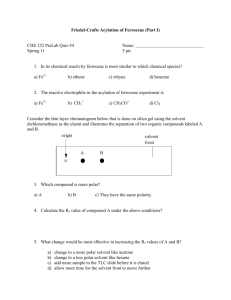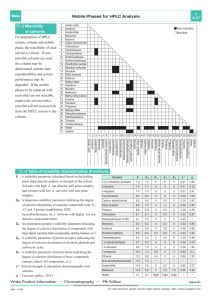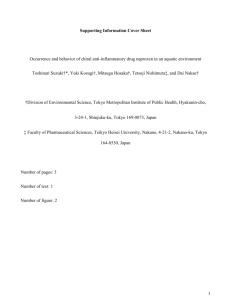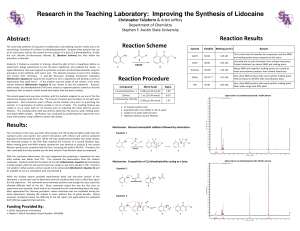Development of a Greener Selective Acylation Method for Steroids
advertisement
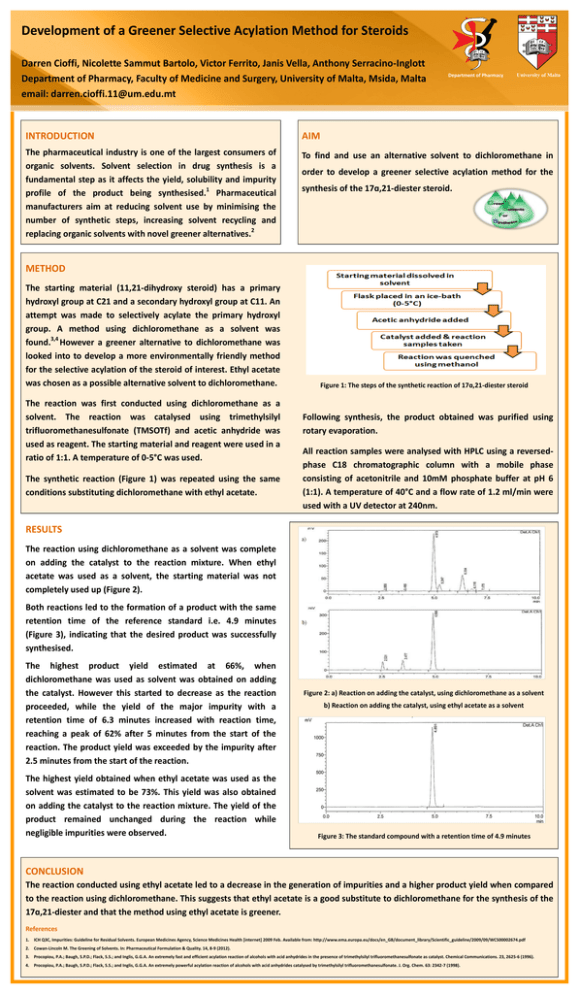
DEPARTMENT OF PHARM ACY UNIVERSI TY OF MA LTA Development of a Greener Selective Acylation Method for Steroids Darren Cioffi, Nicolette Sammut Bartolo, Victor Ferrito, Janis Vella, Anthony Serracino-Inglott Department of Pharmacy, Faculty of Medicine and Surgery, University of Malta, Msida, Malta email: darren.cioffi.11@um.edu.mt Department of Pharmacy University of Malta INTRODUCTION AIM The pharmaceutical industry is one of the largest consumers of organic solvents. Solvent selection in drug synthesis is a fundamental step as it affects the yield, solubility and impurity 1 profile of the product being synthesised. Pharmaceutical manufacturers aim at reducing solvent use by minimising the number of synthetic steps, increasing solvent recycling and 2 replacing organic solvents with novel greener alternatives. To find and use an alternative solvent to dichloromethane in order to develop a greener selective acylation method for the synthesis of the 17ɑ,21-diester steroid. METHOD The starting material (11,21-dihydroxy steroid) has a primary hydroxyl group at C21 and a secondary hydroxyl group at C11. An attempt was made to selectively acylate the primary hydroxyl group. A method using dichloromethane as a solvent was 3,4 found. However a greener alternative to dichloromethane was looked into to develop a more environmentally friendly method for the selective acylation of the steroid of interest. Ethyl acetate was chosen as a possible alternative solvent to dichloromethane. The reaction was first conducted using dichloromethane as a solvent. The reaction was catalysed using trimethylsilyl trifluoromethanesulfonate (TMSOTf) and acetic anhydride was used as reagent. The starting material and reagent were used in a ratio of 1:1. A temperature of 0-5°C was used. The synthetic reaction (Figure 1) was repeated using the same conditions substituting dichloromethane with ethyl acetate. Figure 1: The steps of the synthetic reaction of 17ɑ,21-diester steroid Following synthesis, the product obtained was purified using rotary evaporation. All reaction samples were analysed with HPLC using a reversedphase C18 chromatographic column with a mobile phase consisting of acetonitrile and 10mM phosphate buffer at pH 6 (1:1). A temperature of 40°C and a flow rate of 1.2 ml/min were used with a UV detector at 240nm. RESULTS The reaction using dichloromethane as a solvent was complete on adding the catalyst to the reaction mixture. When ethyl acetate was used as a solvent, the starting material was not completely used up (Figure 2). Both reactions led to the formation of a product with the same retention time of the reference standard i.e. 4.9 minutes (Figure 3), indicating that the desired product was successfully synthesised. The highest product yield estimated at 66%, when dichloromethane was used as solvent was obtained on adding the catalyst. However this started to decrease as the reaction proceeded, while the yield of the major impurity with a retention time of 6.3 minutes increased with reaction time, reaching a peak of 62% after 5 minutes from the start of the reaction. The product yield was exceeded by the impurity after 2.5 minutes from the start of the reaction. The highest yield obtained when ethyl acetate was used as the solvent was estimated to be 73%. This yield was also obtained on adding the catalyst to the reaction mixture. The yield of the product remained unchanged during the reaction while negligible impurities were observed. Figure 2: a) Reaction on adding the catalyst, using dichloromethane as a solvent b) Reaction on adding the catalyst, using ethyl acetate as a solvent Figure 3: The standard compound with a retention time of 4.9 minutes CONCLUSION The reaction conducted using ethyl acetate led to a decrease in the generation of impurities and a higher product yield when compared to the reaction using dichloromethane. This suggests that ethyl acetate is a good substitute to dichloromethane for the synthesis of the 17ɑ,21-diester and that the method using ethyl acetate is greener. References 1. ICH Q3C, Impurities: Guideline for Residual Solvents. European Medicines Agency, Science Medicines Health [internet] 2009 Feb. Available from: http://www.ema.europa.eu/docs/en_GB/document_library/Scientific_guideline/2009/09/WC500002674.pdf 2. Cowan-Lincoln M. The Greening of Solvents. In: Pharmaceutical Formulation & Quality. 14, 8-9 (2012). 3. Procopiou, P.A.; Baugh, S.P.D.; Flack, S.S.; and Inglis, G.G.A. An extremely fast and efficient acylation reaction of alcohols with acid anhydrides in the presence of trimethylsilyl trifluoromethanesulfonate as catalyst. Chemical Communications. 23, 2625-6 (1996). 4. Procopiou, P.A.; Baugh, S.P.D.; Flack, S.S.; and Inglis, G.G.A. An extremely powerful acylation reaction of alcohols with acid anhydrides catalysed by trimethylsilyl trifluoromethanesulfonate. J. Org. Chem. 63: 2342-7 (1998).
